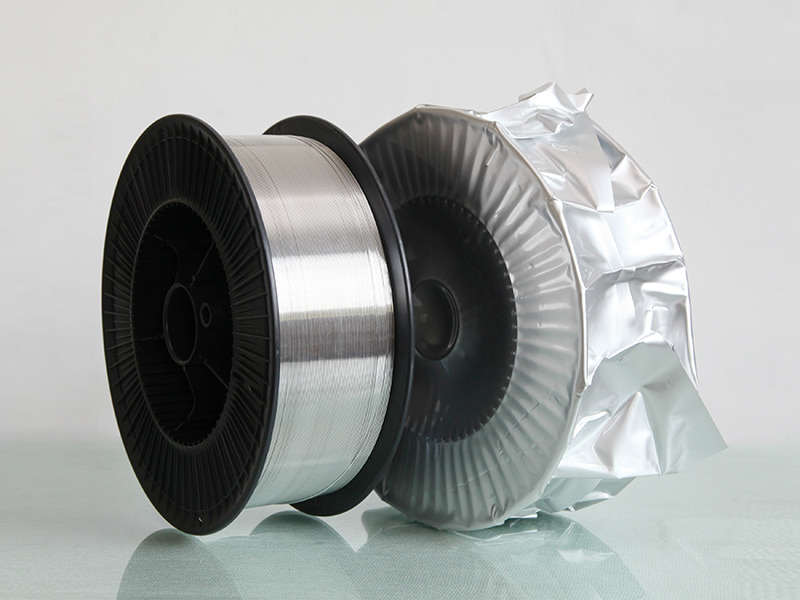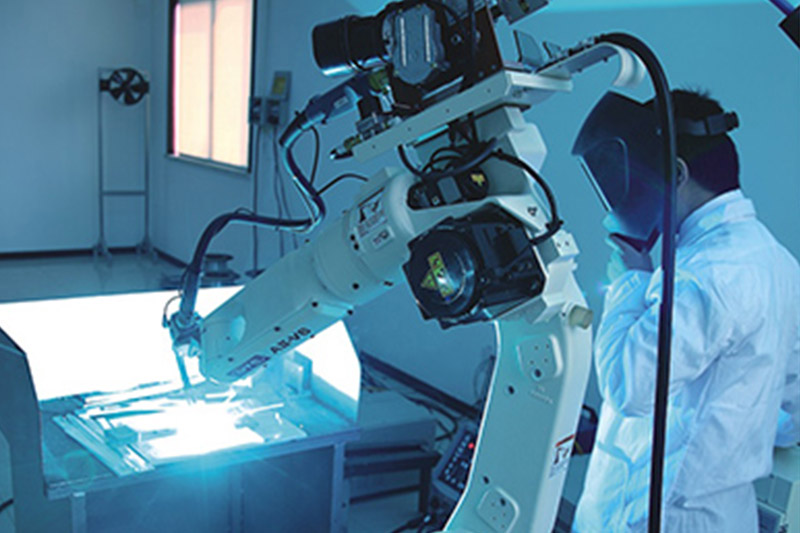Comprehensive Guide to Aluminum Welding Wire
1. Introduction
Aluminum Welding Wire is an indispensable filler material in modern welding, mainly used for welding aluminum and aluminum alloys. Aluminum is widely used in aerospace, automotive manufacturing, shipbuilding, and construction due to its low density, high strength, and corrosion resistance. High-quality Aluminum Welding Wire ensures weld strength and appearance, improves welding efficiency, and reduces material waste.
Choosing the right Aluminum Welding Wire affects not only weld quality but also production costs and process stability. Compared with steel welding wire, aluminum wire has the following characteristics:
| Parameter Category | Aluminum Welding Wire | Steel Welding Wire Comparison |
| Density | 2.7 g/cm³ | 7.85 g/cm³ |
| Thermal Conductivity | High (approx. 237 W/m·K) | Medium (approx. 50 W/m·K) |
| Melting Point | 660°C | 1450°C |
| Welding Current Range | Typically 50–200 A (TIG welding) | Typically 80–300 A |
| Oxidation Tendency | High, requires shielding gas | Low |
| Weld Ductility | Good, prevents brittle cracks | Average |
Aluminum wire's low density and high thermal conductivity require precise heat input control, and its dependence on shielding gas and welding skill is higher. This guide provides a systematic understanding of Aluminum Welding Wire, including selection principles, welding techniques, common issues, and environmentally friendly recycling methods.
2. Basics of Aluminum Welding Wire
Aluminum Welding Wire is a filler metal specifically used for welding aluminum and aluminum alloys. Due to aluminum's low density, high thermal conductivity, and strong corrosion resistance, welding aluminum is more challenging than welding steel. Understanding the basics of aluminum welding wire is crucial for ensuring high-quality welds.
2.1 Types of Aluminum Welding Wire
| Type | Characteristics and Applications |
| Pure Aluminum Wire (AA) | Used for pure aluminum welding, low melting point, good weld flexibility, suitable for thin sheets. |
| Al-Si Alloy Wire | Contains 4–5% silicon, suitable for thick plate welding, reduces weld cracks, improves flowability. |
| Al-Mg Alloy Wire | Contains 3–5% magnesium, high strength and excellent corrosion resistance, commonly used in shipbuilding and chemical equipment. |
| Al-Mn Alloy Wire | Contains ~1% manganese, high weld hardness and oxidation resistance, suitable for aerospace and transportation welding. |
2.2 Key Performance Parameters
| Parameter | Typical Value/Range | Impact on Welding |
| Diameter | 0.8–1.6 mm (TIG welding) | Affects weld penetration and current requirements |
| Melting Point | 577–660°C (depending on alloy) | Determines heat input control and welding speed |
| Thermal Conductivity | 200–240 W/m·K | High thermal conductivity requires precise heat control |
| Ductility | Good, elongation 10–15% | Prevents weld cracking and improves toughness |
| Oxidation Tendency | High, requires inert gas protection | Need argon or helium shielding for TIG/MIG welding |
| Weldability | High but process-sensitive | Improper operation may cause pores or cracks |
2.3 Applications
- Aerospace: Al-Mg wire for aircraft structural parts.
- Automotive: Al-Si wire for chassis and engine components.
- Shipbuilding: Al-Mg wire resistant to seawater corrosion.
- Construction and Decoration: Pure aluminum wire for doors, windows, and curtain walls.
- Chemical Equipment: Al-Mn wire for corrosion-resistant pipes and tanks.
2.4 Usage Precautions
- Clean wire surface to remove oxidation layer.
- Control welding temperature precisely.
- Use proper shielding gas (argon or Ar/He mixture).
- Store in a dry environment.
3. Aluminum Welding Wire Selection Guide
3.1 Selection by Base Material
| Base Material | Recommended Wire | Reason |
| Pure Aluminum Thin Sheet | Pure Aluminum Wire (AA) | Low melting point, good ductility, prevents deformation |
| Al-Si Alloy Thick Plate | Al-Si Alloy Wire | Improves weld flowability, reduces cracks |
| Al-Mg Alloy Component | Al-Mg Alloy Wire | Improves strength and corrosion resistance |
| Al-Mn Alloy Structural Part | Al-Mn Alloy Wire | Higher hardness and oxidation resistance |
3.2 Selection by Welding Method
| Welding Method | Wire Diameter | Welding Features |
| TIG Welding | 0.8–1.6 mm | Precise heat input, fine welds, suitable for thin sheets and high-precision welding |
| MIG Welding | 1.0–2.0 mm | Fast welding, suitable for thick plates and large areas |
| Manual Welding | 1.0–1.5 mm | Suitable for small structures or field repair, flexible |
3.3 Composition vs Weld Performance
| Wire Type | Al Content | Si Content | Mg Content | Weld Strength | Corrosion Resistance | Ductility |
| Pure Aluminum Wire | ≥99% | 0 | 0 | Medium | Medium | High |
| Al-Si Alloy Wire | 90–95% | 4–5% | 0 | High | Good | Good |
| Al-Mg Alloy Wire | 90–94% | 0 | 3–5% | High | High | Medium |
| Al-Mn Alloy Wire | 95–97% | 0 | 0 | High | High | Medium |
3.4 Environmental and Special Considerations
- Thin Sheet: Use pure aluminum or low-Si wire, control heat input.
- Thick Plate: Use Al-Si or Al-Mg wire to improve flowability and strength.
- High Corrosion: Use Al-Mg or Al-Mn wire for marine or chemical environments.
- High Precision: TIG with smaller wire diameter for smooth welds.
3.5 Practical Selection Summary
- Match base material composition for weld strength and fewer defects.
- Consider welding method for wire diameter and type.
- Consider environment for corrosion resistance and quality.
- Store and handle wire properly to maintain stability.
4. TIG Welding Tips for Aluminum Wire
4.1 Preparation
- Clean base material to remove oxide layer.
- Ensure wire is clean and dry.
- Use proper shielding gas, 10–20 L/min.
4.2 Welding Parameters
| Parameter | Recommended Range | Note |
| Current | 50–200 A | Low for thin sheets, high for thick plates |
| Wire Diameter | 0.8–1.6 mm | Larger diameter increases penetration but harder to control |
| Argon Flow | 10–20 L/min | Protect weld from oxidation |
| Welding Speed | 2–8 cm/min | Ensure uniform fusion, avoid spatter |
| Heat Input | Low to medium | Prevent thin plate overheating |
4.3 Welding Techniques
- Feed wire evenly, keep weld width consistent.
- Maintain 2–3 mm tungsten-to-workpiece distance.
- Thin sheets: spot weld + short travel; thick plates: slight weave.
- Control molten pool temperature.
4.4 Common Problems and Solutions
| Problem | Cause | Solution |
| Pores | Surface contamination, insufficient shielding gas | Clean material, increase gas flow |
| Cracks | Uneven heat input or wrong wire | Adjust current and speed, use matching wire |
| Spatter or uneven weld | Uneven wire feed or high current | Feed wire evenly, adjust current and speed |
| Gray weld surface | Oxide layer not removed | Clean surface, ensure gas coverage |
5. Common Aluminum Wire Welding Issues
5.1 Weld Porosity
Appearance: Small holes inside or on weld surface, reducing strength.
Causes: Contaminated surface, insufficient gas, fast welding.
Solutions: Clean materials, dry wire, adjust gas flow and travel speed.
5.2 Weld Cracks
Appearance: Fine cracks along fusion zone, weak weld.
Causes: Uneven heat, mismatched wire, improper cooling.
Solutions: Use matching wire, adjust current/speed, layer welding for thick plates.
5.3 Weld Undercut or Spatter
Appearance: Uneven surface or high weld bead.
Causes: Uneven wire feed, high current, wrong angle.
Solutions: Feed wire evenly, adjust current, maintain angle.
5.4 Weld Surface Oxidation
Appearance: Gray or dark weld surface.
Causes: Insufficient shielding gas, oxide layer, high humidity.
Solutions: Adequate gas coverage, clean surface, dry wire.
6. Welding Defect Analysis
6.1 Lack of Fusion or Penetration
Appearance: Weld not fully fused, insufficient depth, low strength.
Causes: Low current, fast speed, wrong angle, contamination.
Prevention: Adjust current/speed, correct angle, clean surface.
6.2 Porosity and Inclusion
Causes: Wet wire/material, insufficient gas, improper temperature.
Prevention: Dry wire, adjust gas, control speed/current.
6.3 Cracks
Causes: High thermal stress, wire mismatch, rapid cooling or short layer interval.
Prevention: Match wire, control heat input, uniform layer welding.
6.4 Weld Spatter or Undercut
Causes: Uneven wire feed, high current, incorrect torch angle.
Prevention: Feed wire evenly, adjust current/speed, correct angle.
6.5 Surface Oxidation or Color Change
Causes: Insufficient gas, oxide layer, high humidity.
Prevention: Adequate gas coverage, clean wire/material, dry storage.
7. Aluminum Wire Environmental Recycling
7.1 Waste Wire Recycling
- Melting and remanufacturing into new wire or aluminum products.
- Mechanical recycling for low-grade aluminum products.
- Ensure separation from iron/copper and dry treatment.
7.2 Welding Scrap Reuse
- Collect and classify by alloy composition.
- Compress and store.
- Remelt for low-thickness plates, profiles, or wire raw material.
- Ensure purity and remove contaminants.
7.3 Eco-Friendly Wire Application
- Optimized alloys reduce harmful gas emissions.
- Efficient welding reduces energy consumption.
- Minimized spatter and waste through process optimization.
7.4 Advantages of Recycling
| Benefit | Details |
| Resource Saving | Recycles scrap wire, reduces raw material use |
| Cost Control | Use recycled aluminum for low-grade wire/products |
| Environmental Protection | Reduces waste and harmful gas emissions |
| Corporate Image | Shows green production and sustainability |
7.5 Practical Steps
- Collect and classify wire.
- Dry storage.
- Remelt for reuse.
- Optimize welding to reduce waste.
8. Conclusion
- Wire Selection: Match base material, welding method, environment, and thickness.
- Welding Technique: Even wire feed, control molten pool, adjust current and speed.
- Defect Control: Prevent pores, cracks, spatter, under-penetration by proper wire and process.
- Environmental Recycling: Recycle scrap, optimize process, reduce costs, and protect environment.
Mastering Aluminum Welding Wire selection, welding techniques, defect control, and recycling ensures high-quality welds and sustainable production.
FAQ
1. How to Choose Aluminum Welding Wire?
Answer: Choose Aluminum Welding Wire based on base material type, welding method, and working environment. Thin sheets can use pure aluminum wire (AA), while thick plates or high-strength structures may require Al-Si, Al-Mg, or Al-Mn wire. TIG, MIG, and manual welding require matching wire diameters. Ensure clean base material and sufficient shielding gas.
Hangzhou Kunli welding materials Co., Ltd. is a high-tech enterprise located in Puyang Town, Xiaoshan District, Hangzhou, Zhejiang Province, specializing in high-performance aluminum alloy welding wire. The company provides certified Aluminum Welding Wire suitable for various welding applications.
2. Common Welding Issues and Prevention
Answer: Common problems include pores, cracks, spatter, undercut, and surface oxidation, usually caused by contamination, insufficient gas, or improper wire matching.
Prevention: Clean materials, use dry wire, ensure sufficient shielding gas, adjust current and speed, and perform layer welding for thick plates.
Hangzhou Kunli welding materials Co., Ltd. has over 20 years of experience and advanced technology, producing stable Aluminum Welding Wire to reduce welding defects.
3. How to Recycle and Sustain Aluminum Welding Wire?
Answer: Waste wire and scraps can be remelted or mechanically recycled. Optimize welding process and wire selection to reduce waste.
Hangzhou Kunli welding materials Co., Ltd. produces over 200 MT per month, with 50% exported to more than 30 countries. The company emphasizes environmental protection and sustainable production.
NEXT:Comprehensive Guide to ER5356 Aluminum Welding Wire: Selection, Applications, and Welding Instructions
Related Products
-
 View More
View More
5154 Aluminum Alloy Welding Wire
-
 View More
View More
ER4043 Silicon Aluminum Welding Wire
-
 View More
View More
ER4047 Aluminum Mig Welding Wire
-
 View More
View More
ER5154 Al-Mg Alloy Wire
-
 View More
View More
ER5087 Magnesium Aluminum Welding Wire
-
 View More
View More
Aluminum Welding Wire ER5183
-
 View More
View More
ER5356 Aluminum Welding Wire
-
 View More
View More
ER5554 Aluminum Welding Wire
-
 View More
View More
ER5556 Aluminum Welding Wire
-
 View More
View More
ER1100 Aluminum Welding Wire
-
 View More
View More
ER5754 Aluminum Welding Wire
-
 View More
View More
ER2319 Aluminum Welding Wire
 English
English Deutsch
Deutsch
 English
English Deutsch
Deutsch



